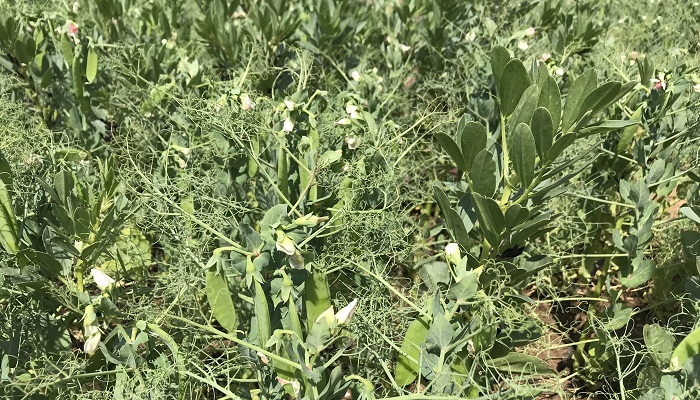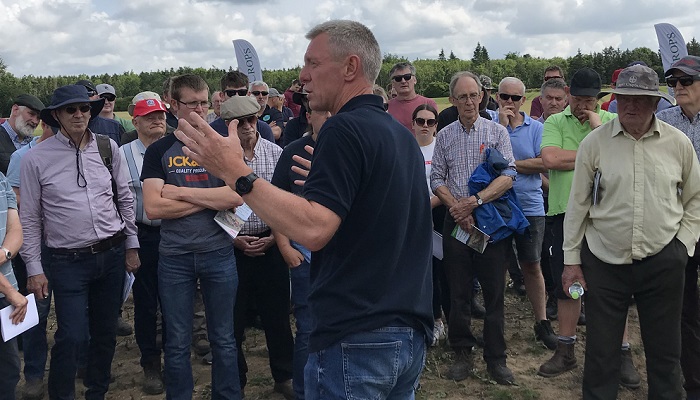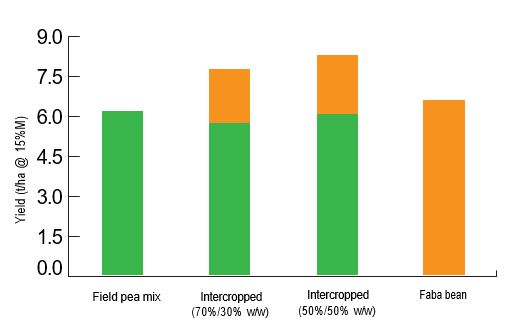24 June 2023
A solution to the pea crop’s Achilles’ heel?

Pea crops have been grown in Ireland for generations. However, the popularity of the crop is often dampened by its Achilles’ heel of lodging and the resulting challenges this brings at harvest time.
This week’s Crops and Cover Crop Cultivations Open Day in Teagasc Oak Park highlighted the important role protein crops – such as beans, peas and lupins – will play in future cropping on Irish farms. By 2030, the goal is to increase the production of indigenous protein crops to 120,000t from a land area of 20,000ha.
Touching on the benefits, Teagasc Crops Specialist Ciaran Collins explained: “The benefits of legumes are well known. We all know the benefits they bring to the rotation. In Oak Park trials, we are seeing a 1.5t/ha increase in wheat yields after break crops compared to continuous tillage, so that is obviously a huge benefit.”
Along with their function as a break crop, legumes are combinable crops that improve soil structure and resilience; promote pollinator activity; have high yield potential; have the capabilities to fix biological nitrogen, resulting in the potential to reduce nitrogen applications in the following cereal crops; and are eligible for the Protein Aid Payment.
Typically sold into the animal feed market, one area which is seen to have great potential for protein or legume crops is the food-based protein market, which is a high-value market.
“Currently we import all of our food-based protein ingredients. There is a big market there and we are very good at growing legumes in this country. It is a market that we are well able to tap into and Teagasc is looking at technologies to develop those food-based ingredients,” Ciaran noted. Two major projects are currently underway in this area VALPRO Path and U-Protein.

Photo caption: Ciaran Collins, Teagasc Crops Specialist, outlining the plant protein research being carried out in Teagasc Oak Park.
In terms of the protein crops currently being grown in Ireland, faba beans is the most established. But Ciaran commented that “peas and lupins certainly have massive potential not only in the yield they can give us as farmers but also in their added value”.
“Peas have massive potential. We can sow them a little bit later than beans and we can harvest them a little bit earlier. We get very good yields of peas and they are suited to lighter soils. Challenges do exist with lodging, but intercropping with peas and beans worked really well last year,” Ciaran explained.
Shelia Alves, a Teagasc Research Officer in Minor Crops Agronomy and Alternative Markets, provided an overview of the intercropping research being conducted at Oak Park.
She said: “Ireland is a very small country, but it can have very different climates. Some places have sufficient moisture to grow faba beans. Where we don’t have the sufficient moisture and heavy soil texture, faba beans don’t yield as well, so we need to have other crops in the pipeline.”
To meet this challenge, the research programme at Teagasc Oak Park is examining a wide range of protein crops, suitable for a range of growing conditions, including lentils, lupins, peas and beans.
On intercropping, she said: “Peas have been a long established crop in Ireland but have declined in popularity due to difficulties at harvest. The way we are trying to manage this is to introduce a small quantity of faba beans in the pea crop so that they work as a scaffold and don’t let the pea crop lodge.”
Trials have been undertaken using 100% pea, 100% faba bean and a 50:50 and 70:30 pea and bean mix, with harvesting dates of the pea and bean crops matched. The initial results of the project are promising, with intercropped trials yielding more than either the single strain pea or bean crops (figure 1 below).
Figure 1. Mean yield (t/ha) of spring field pea mixture (green column) and faba bean (orange column) in intercropping trials. The total sowing rate of mix stands and sole plots of faba beans and field peas was 190 kg/ha.

A further trial was also carried out examining the effect of intercropping on winter pea varieties. Again the inclusion of the beans within the pea crops had positives, with both the intercropped and bean monocultures still standing for harvest in late August.
However, as Shelia added: “When peas were grown without the stabilisation effect of the faba bean, we lost the crop at the end of August. The crop completely lodged and shattered. At the same time, our intercropping plots at different ratios were still standing.”
More information on this research work is available here.
Also read: Mechanical weed control demonstration in field vegetables at Oak Park
Also read: Highlights from the Teagasc Crops Open Day
Also read: Developing better tools for the forecasting and control of BYDV
